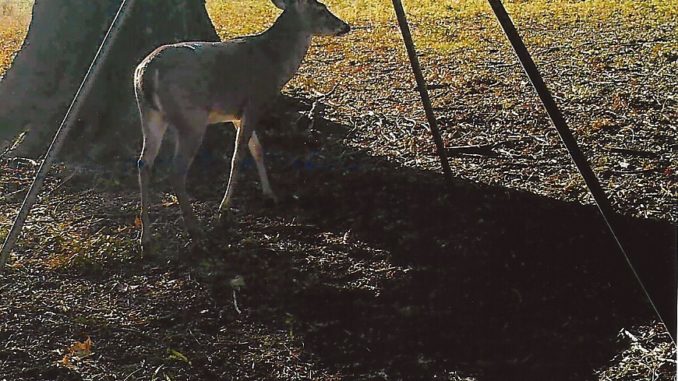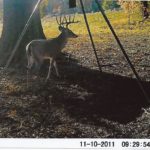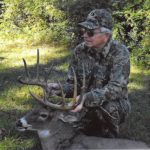
Chasing the dream continues
The old Carol Burnett Show used to end with the phrase “Seems we just got started and before you know, it’s time to go.” For me it seems the deer season just opened, and now this is the last month of the season. Of course I am writing this column on Dec. 6 in order to meet the printing deadline, so I actually still have two full months of deer hunting, and the best is definitely yet to come for us who hunt the deer that breed in December and January.
We noticed a chase going on in the woods the last day of November in Clinton. Within the breeding range of a deer herd, there will be a few does that begin to cycle early, and as the days progress, the rest of the does will cycle. I am looking at our breeding peak in Clinton occurring prior to and perhaps during the week of Christmas, and the first round of breeding in the late Area 6 parishes occurring one month later, during our second round of breeding. The scrape activity will be intense prior to the actual breeding, so don’t hesitate to hunt the active scrapes in early January.
November gave us some pretty unseasonably warm hunting weather, and it appeared that the breeding in Area 2 hit around Thanksgiving. My friend Jim Morris of Baton Rouge killed a fine buck in early November in Sabine Parish in Area 2. I asked him if it was chasing a doe, and he said it was just moving through the pine timber. This buck looks as if it could score in the 150s, maybe the low 160s. His grandson told him, “PawPaw that is a buck of a lifetime,” and indeed it is. I like seeing the photos of the youngsters having success, but it is good to see the older legion of hunters having success. That is a buck to talk about for a long time.
My friend Ken Mason in Bossier Parish saw action during the last week of November; if he comes through with some reproductive tracts from a few does they take in the late season, we will know exactly when the breeding occurred.
I have been getting photographs of what I think is a B&C buck in DeSoto Parish. The buck was visiting feeders in open daylight, and disproves the theory that big bucks do not move around during daylight hours. It just goes to show what hunting pressure will do to the deer herd. It does not take long for the deer to catch-on that hunting season is in progress and hunters are out and about.
The more you can control and regulate the human activity during the season, the better the hunting will be. I think we all can use a little more exercise and keep the ATV traffic for the real dirty work. As the season progresses and the deer sightings, decline it may be worthy to get away from the permanent stands and utilize the climbers or ground blinds and create a new set-up. When deer start looking up at stands to see if they can detect a hunter it is time for a change.
Richard McMullan wrote an article in one of the old DMAP newsletters about hunting between the stands. Once deer become alerted to stand locations, their movements will change in response to them, and setting up in a totally new area, between permanent stands, may help you punch a tag.
December is usually the month I starting filling tags, but I was blessed and bagged two adult does in November. I am in the habit of practicing the act of “first fruits,” which is simply sharing the first fruit of whatever with friends and neighbors. I have been sharing the mustard and turnip greens that we are growing at Camp David for several weeks, and I shared the venison with them also.
I noticed while working the Clean out Your Freezer Day this past September in Baton Rouge that everyone is killing plenty of game and catching plenty of fish. The duck limits must be OK because there were a lot of waterfowl being donated along with redfish and speckled trout. Here is a novel idea: share the bounty with friends and neighbors and the local food bank whenever you have a successful outing, and you won’t have to spend so much time cleaning out the freezer. The Hunters for the Hungry Program has several locations where you can drop off a deer, and they will process it and give it to the food banks, so don’t wait until next fall to help out with this need.
While the weather was unseasonably warm, another problem for deer hunters is the abundant crop of acorns. A walk through the woods normally produces a crunching sound of boots on dry leaves, but this year it is boots on acorns. It is a phenomenal crop of acorns, both red oaks and white oaks, and all the species of wildlife that eat acorns are certainly going to benefit. This mast crop will provide food for the game well into spring. Deer should be quite fat and healthy going into spring, and body growth and antler development should be good next fall, as should reproduction.
I have been looking at deer stomachs at several locations since the season opened, and the diet of deer is heavy with the acorns. This is a year that you can save money and not have to buy so much corn if you have a good oak tree component in your woods. I actually counted the acorns in the stomach of a doe killed in the upper Morganza Floodway, and I counted 534 water oak acorns. These were acorns that had been swallowed whole, and there were probably 50-100 more that had been somewhat broken up in the chewing process. It also had 13 striped oak acorns.
In the Clinton area, cherry bark oak and white oak acorns are being eaten the most. Again, if the deer seem to have disappeared, it may be because they are getting plenty to eat elsewhere and do not have to visit your food plot or feeder. With so much food available, a deer can fill up quickly and then go bed down to chew its cud, and overall movement will be minimal.
A good food plot, one that has good grass and clover and has been well fertilized and limed, may pay off once the rut is over and the deer go back to the feeding mode. The state was getting some much needed rain in early December, and now would be the time to apply some additional fertilizer to the plot to keep it nutritious for the deer.
The deer at Camp David have the Area 2 genetics, and while we were getting photos of several racked bucks prior to Nov. 12, once the rut started the deer left, but I am hoping the best is yet to come for us as they come back and feed in the patches in the late season.
ADDENDUM: On Dec. 8, two days after writing this column, I was in the deer stand at daylight. The temperature was 25 degrees, and the barometric pressure was 30.05 and rising — the best day of the deer season to date. The deer started moving at 7 a.m., and at 8 a.m., I collected a 3 1/2-year-old 6-point. When days in January are similar to this one, it is time to be in the deer stand!




